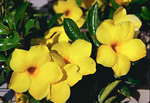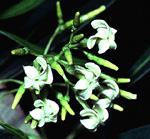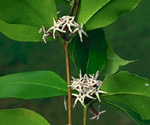 |
This is a large, pantropical family, represented in Australia mostly by tropical plants, typically in dry rainforests (vine scrubs). A few extend into semi-arid parts and into temperate southern Australia.
Characteristic features of the family Apocynaceae in Australia include: - mostly climbers, shrubs or herbs, less commonly trees
- stems often with a milky or clear latex
- leaves simple, usually opposite or whorled, often with a patch of small glands (colleters) near the base of the lamina
- flowers often salverform (with a narrow, tubular base and spreading lobes), sometimes with a corona of appendages at the throat of the tube
- fruit usually a berry, drupe, or a follicle or pair of follicles (often large and woody), splitting to release the small seeds which usually have a coma of fine hairs to aid wind dispersal
Description
Evergreen or deciduous trees, shrubs, or woody or herbaceous vines scrambling or climbing by twining stems, or perennial terrestrial herbs perennating by rhizomes, stolons, taproots or crowns. Extra-floral nectaries absent or on the foliage. Stems unarmed or rarely with thorns or spines arising from the leaf axils; nodes conspicuously swollen or not; internodes terete or oval or slightly flattened. Internal secretions of milky sap (latex) or coloured sap. Plants glabrous or with simple, non-glandular, unicellular or uniseriate hairs. Leaves distichous, opposite or whorled; leaves in each whorl 3–6, cauline if herbs, petiolate, subsessile or sessile. Stipules present, distinct and free from the petiole; scale-like or membranous or spine-like; falling off early or persistent. Lamina simple, symmetric, filiform, acicular, subulate, linear, lanceolate, ovate, elliptic, oblanceolate, ovate, oblong or orbicular; base cuneate, attenuate, rounded, cordate, lobed or auriculate or truncate; margins entire, dentate or serrate, sinuate or spiny, ±flat, revolute or recurved; one-veined, or the venation pinnate, or not obvious, with the midrib conspicuous, and the tertiary venation reticulate or not; surfaces not punctate; herbaceous, leathery or hard and spinose. Domatia present. All the flowers bisexual. Inflorescences terminal or axillary, consisting of panicles, umbels, or dichasial or monochasial cymes, or rarely spikes. Bracts present. Mucilaginous hairs present or absent on buds. Pollination by insects. Flowers odourless or fragrant; sessile or stalked. Floral disc present or absent; nectaries absent or present on the disc. Perianth regular, of 2 dissimilar whorls, imbricate or valvate in bud. Calyx segments fused, with 4–5 lobes, herbaceous or membranous. Corolla segments fused, with 4–5 lobes, alternating with the calyx lobes; corolla wheel-shaped, bell-shaped, urn-shaped, funnel-shaped or salver-shaped, white, cream, yellow, orange, red, pink, magenta, purple, violet or green, without contrasting markings, or streaked, spotted, etc, membranous or succulent; lobes ±entire; tube with or without wings or coronal appendages Fertile stamens 5, alternating with the calyx lobes, at least partly fused to the corolla, free of ovary and style, distinct from each other, all ±equal. Anthers dorsifixed, not versatile, opening outwards by longitudinal slits; 2-celled; with appendages absent or apical. Ovary superior and sessile. Carpels 2, fused (or free below with fused styles); ovary with 1–2 locules. Style terminal, single, unbranched and the stigma conical. Ovules 1–numerous per locule, stalked; placentation parietal or axile. Fruit a dry loculicidal capsule, or a follicle, or a fleshy indehiscent berry or drupe; the perianth on the maturing fruit deciduous. Disseminule macro-surface featureless or with a coma of hairs, white, cream, brown, grey or black, without contrasting markings, or conspicuously patterned, dull. Seeds 1–numerous per fruit. Aril absent. Cotyledons 2. Embryo straight.
(Note: this description has been generated from the coded data compiled for the key. Any errors in the key data will be reflected in the descriptions.)
A treatment of the family Apocynaceae has been published in:
Flora of Australia 28: 104-196.
Australian genera of Apocynaceae (as recognised for the Flora of Australia)
* = all species introduced
*Allamanda
Alstonia
Alyxia
Carissa
*Cascabela
*Catharanthus
Cerbera
Chonemorpha
Ichnocarpus
Kopsia
*Mandevilla
Melodinus
Neisosperma
*Nerium
Ochrosia
Parsonsia
*Rauvolfia
Tabernaemontana
*Vinca
Voacanga
Wrightia

|
  |

Allamanda schottii (flowers)
Photo: D.Jones © D.Jones

Alstonia actinophylla (flowers)
Photo: G.Sankowski © Zodiac Publications

Alyxia buxifolia (flowers and fruit)
Photo: M.Fagg © M.Fagg

Alyxia magnifolia (flowers)
Photo: G.Leiper © G.Leiper

|
 |
|